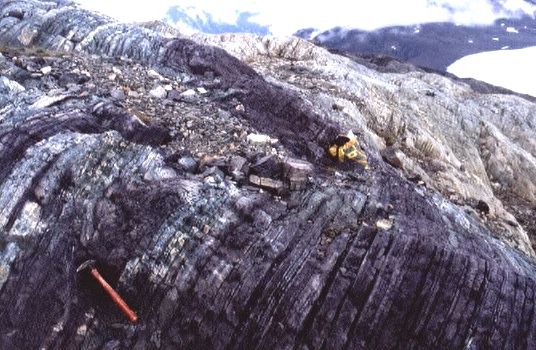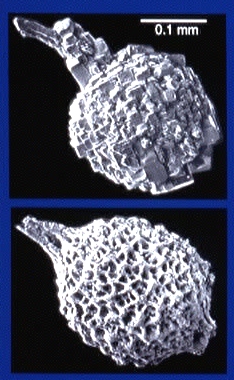Contribution to mining exploration: Red Mountain gold deposit
Charlie Greig by a metachert outcrop on Red Mountain. This locality yielded metamorphosed, pyritized radiolarians of Triassic age (se below) |
|
Late Permian radiolarian chert succession on a nunatak by Cambria Icefield near Red Mountain. |
| Chronostratigraphic control on Red Mountain
The work undertaken in the vicinity of Red Mountain confirms the potential of radiolarian microfossils to contribute to the understanding of mineral deposits. Twenty productive localities from ribbon chert and siliceous siltstones yield radiolarians which range in age from Early Permian (Sakmarian) to Middle Jurassic (Bajocian-Bathonian). Among these localities are the first known age control from stratified rocks hosting the Red Mountain gold deposit.The Middle and Late Triassic fine-grained siliceous clastic rocks grade upward into coarser-grained volcaniclastic and volcanic rocks. Both packages sills and dykes which yield Early Jurassic U-Pb age are genetically related to Au mineralization. Scanning
Electron Microscope pictures of radiolarians from Red Mtn. Top: silica
shell was replaced by pyrite crystals linked to mineralization. Bottom:
also pyritized, the shell framework of this morphotype is preserved.
Taxa can be identified and date the mineralized strata (Middle Triassic).
|
| Tectonic Significance Our study shows that in the Cambria-Kinskuch area, green, black, red, and rare pink Early Permian to Late Triassic radiolarian ribbon cherts are the oldest rocks underlying typical uppermost Triassic and Early Jurassic arc volcanic rocks of westernmost Stikinia. The cherts are discontinuously exposed over a distance of 50 km within mid-Cretaceous structural culminations west of Bowser Basin, and are distinctly different from Paleozoic carbonate and volcanic rocks characteristic of most other parts of Stikinia. Chert deposition appear to have been continuous for part of the Permian and Triassic, a period of approximately 70 Ma, and a pelagic depositional environment with little clastic input is inferred. The chert sequence appears to grade upward into a black and dark grey fine-grained clastic sequence with local chert which have yielded Late Carnian-Middle Norian and Norian radiolarian fauna and Late(?) Norian/Rhaetian conodont fauna (M.J. Orchard in Cordey et al., 1992). Together, the two packages were deformed and then overlain unconformably by pyroxene-bearing basalt, sandstone, siltstone, and local carbonate and chert pebble conglomerate which occur at the base of an early Mesozoic section typical of Stikinia elsewhere. A latest Norian/Rhaetian conodont fauna was obtained from carbonate of the overlying rocks, which suggests that deformation was followed very closely by the initiation of volcanism. The chert-clastic package possibly represents the remnants of an ocean basin that in present-day coordinates lies west of Stikinia. That is was deformed in latest Triassic time, prior to eruption of Stikinian arc volcanic rocks, suggests that its closure may be linked with latest Triassic-earliest Jurassic deformation common to Stikinia and the Yukon-Tanana terrane, which at this latitude also borders Stikinia on the west. The earliest links between the two terranes, which occurred in latest Triassic time, are consistent with this hypothesis. |
 This
biostratigraphic study (FC) has been undertaken in support of regional
mapping in Stewart area (NW British Columbia) by Charlie Greig with
funding from Lac Minerals Ltd - American Barrick Ltd and
the Geological Survey of Canada. Previous work in the Stikine
terrane has shown that radiolarians provide age constraints for Permian,
Triassic and Jurassic mappable units that span much of the stratigraphic
range of the terrane (Cordey et al., 1992). Specific techniques of
This
biostratigraphic study (FC) has been undertaken in support of regional
mapping in Stewart area (NW British Columbia) by Charlie Greig with
funding from Lac Minerals Ltd - American Barrick Ltd and
the Geological Survey of Canada. Previous work in the Stikine
terrane has shown that radiolarians provide age constraints for Permian,
Triassic and Jurassic mappable units that span much of the stratigraphic
range of the terrane (Cordey et al., 1992). Specific techniques of 
